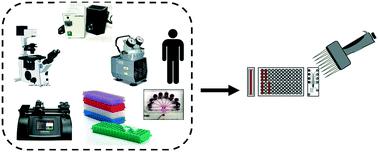Our official English website, www.x-mol.net, welcomes your
feedback! (Note: you will need to create a separate account there.)
Point of care whole blood microfluidics for detecting and managing thrombotic and bleeding risks
Lab on a Chip ( IF 6.1 ) Pub Date : 2021-08-31 , DOI: 10.1039/d1lc00465d Scott L Diamond 1 , Jason M Rossi 1
Lab on a Chip ( IF 6.1 ) Pub Date : 2021-08-31 , DOI: 10.1039/d1lc00465d Scott L Diamond 1 , Jason M Rossi 1
Affiliation

|
Point-of-care diagnostics of platelet and coagulation function present demanding challenges. Current clinical diagnostics often use centrifuged plasmas or platelets and frozen plasma standards, recombinant protein standards, or even venoms. Almost all commercialized tests of blood do not recreate the in vivo hemodynamics where platelets accumulate to high densities and thrombin is generated from a procoagulant surface. Despite numerous drugs that target platelets, insufficient coagulation, or excess coagulation, POC blood testing is essentially limited to viscoelastic methods that provide a clotting time, clot strength, and clot lysis, while used mostly in trauma centers with specialized capabilities. Microfluidics now allows small volumes of whole blood (<1 mL) to be tested under venous or arterial shear rates with multi-color readouts to follow platelet function, thrombin generation, fibrin production, and clot stability. Injection molded chips containing pre-patterned fibrillar collagen and lipidated tissue factor can be stored dry for 6 months at 4C, thus allowing rapid blood testing on single-use disposable chips. Using only a small imaging microscope and micropump, these microfluidic devices can detect platelet inhibitors, direct oral anticoagulants (DOACs) and their reversal agents. POC microfluidics are ideal for neonatal surgical applications that involve small blood samples, rapid DOAC testing in stroke or bleeding or emergency surgery situations with patients presenting high risk cofactors for either bleeding or thrombosis.
中文翻译:

用于检测和管理血栓和出血风险的护理点全血微流体
血小板和凝血功能的即时诊断提出了严峻的挑战。目前的临床诊断经常使用离心血浆或血小板以及冷冻血浆标准品、重组蛋白标准品,甚至毒液。几乎所有商业化的血液测试都不能重现体内血流动力学,其中血小板聚集到高密度并且凝血酶是从促凝血表面产生的。尽管有许多针对血小板、凝血不足或凝血过度的药物,但 POC 血液检测本质上仅限于提供凝血时间、凝块强度和凝块溶解的粘弹性方法,而主要用于具有专门能力的创伤中心。微流体现在允许在静脉或动脉剪切率下测试少量全血(<1 mL),并通过多色读数来跟踪血小板功能、凝血酶生成、纤维蛋白生成和凝块稳定性。含有预图案化纤维胶原和脂化组织因子的注塑芯片可以在 4℃ 下干燥保存 6 个月,从而可以在一次性芯片上进行快速血液检测。仅使用小型成像显微镜和微泵,这些微流体装置就可以检测血小板抑制剂、直接口服抗凝剂(DOAC)及其逆转剂。POC 微流体非常适合涉及小血样的新生儿手术应用、中风或出血或紧急手术情况下的快速 DOAC 测试(患者存在出血或血栓形成的高风险辅助因素)。
更新日期:2021-09-03
中文翻译:

用于检测和管理血栓和出血风险的护理点全血微流体
血小板和凝血功能的即时诊断提出了严峻的挑战。目前的临床诊断经常使用离心血浆或血小板以及冷冻血浆标准品、重组蛋白标准品,甚至毒液。几乎所有商业化的血液测试都不能重现体内血流动力学,其中血小板聚集到高密度并且凝血酶是从促凝血表面产生的。尽管有许多针对血小板、凝血不足或凝血过度的药物,但 POC 血液检测本质上仅限于提供凝血时间、凝块强度和凝块溶解的粘弹性方法,而主要用于具有专门能力的创伤中心。微流体现在允许在静脉或动脉剪切率下测试少量全血(<1 mL),并通过多色读数来跟踪血小板功能、凝血酶生成、纤维蛋白生成和凝块稳定性。含有预图案化纤维胶原和脂化组织因子的注塑芯片可以在 4℃ 下干燥保存 6 个月,从而可以在一次性芯片上进行快速血液检测。仅使用小型成像显微镜和微泵,这些微流体装置就可以检测血小板抑制剂、直接口服抗凝剂(DOAC)及其逆转剂。POC 微流体非常适合涉及小血样的新生儿手术应用、中风或出血或紧急手术情况下的快速 DOAC 测试(患者存在出血或血栓形成的高风险辅助因素)。











































 京公网安备 11010802027423号
京公网安备 11010802027423号